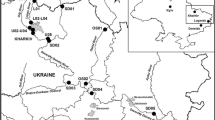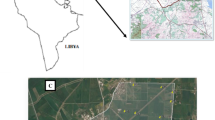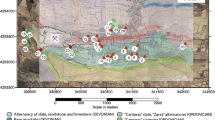Abstract
Detailed research on the content of heavy metals in ground and surface waters in the upper Sanna River catchment was initiated in 2013. The investigations were conducted in one of the most promising areas of potential shale gas extraction, in which the Frampol 1 test wellbore was drilled in 2012 (SE Poland, Roztocze Region). In the area of the wellbore, hydrochemical analyses of the waters of the river drainage zone were performed. Water was sampled from six objects representing soil water, porous groundwater, fissure-layer groundwater, and river water. The hydrological regime of groundwater and surface water was analysed based on data obtained from automatic recorders of water levels and results of periodic measurements of water flow. In 2013, water was sampled on a monthly basis for determination of the levels of Ba, Sr, Al, Fe, Mn, Zn, Cu, Cd, Co, Cr, Ni, As, V, Rb, Pb, Th, and U. The analysis results showed that the concentration of Sr was usually in the range of 100–400 µg/L, Fe 10–100 µg/L, Ba 10–40 µg/L, and Mn, Al, and Zn 1–10 µg/L. The concentration of the other metals generally did not exceed 1 µg/L. The concentrations of the elements analysed in the zone of drinking water intake were within the range specified by Polish and WHO standards. Significant differences were found in the metal content in the analysed waters; they were related to the water intake site, form of land management, and hydrometeorological conditions. The highest metal content was recorded in soil and river waters and the lowest in the spring waters of the main water-bearing horizon. At the current stage of the research, no impact of the Frampol 1 shale gas exploration wellbore on the metal content in the upper Sanna River catchment was found.




Similar content being viewed by others
References
Appelo CAJ, Postma D (1993) Geochemistry, groundwater and pollution. A.A. Balkema, Rotterdam
Chibowski S, Chmiel S, Michalczyk Z, Solecki J, Szczypa J (1998) Monitoringowe badania stanu jakości wód oraz skażeń radiochemicznych gleb i roślinności Roztocza. Prz Geol 46:873–880
Chiżniakow AW, Żelechowski AM (1974) Zarys tektoniki obszaru lubelsko-lwowskiego. Kwart Geol 18(4):707–719
Chmiel S (2005) Rola zasilania podziemnego i spływu powierzchniowego w kształtowaniu cech fizykochemicznych wód rzecznych Wyżyny Lubelskiej i Roztocza. Wyd UMCS, Lublin
Chmiel S, Michalczyk Z (2003) Aktualny stan hydrochemiczny wód źródlanych Wyżyny Lubelskiej i Roztocza. Współczesne Problemy Hydrogeologii 11(2), Wyd Bud Wod i Inż Środ, Gdańsk, pp 65-71
Gassiat C, Gleeson T, Lefebvre R, McKenzie J (2013) Hydraulic fracturing in faulted sedimentary basins: numerical simulation of potential contamination of shallow aquifers over long time scales. Water Resour Res 49(12):8310–8327. doi:10.1002/2013WR014287
Gordalla B, Ewers U, Frimmel FH (2013) Hydraulic fracturing-a toxicological threat for groundwater and drinking water? Environ Earth Sci 70:3875–3893. doi:10.1007/s12665-013-2672-9
Herbich P, Przytuła E (2012) Bilans wodnogospodarczy wód podziemnych z uwzględnieniem oddziaływania z wodami powierzchniowymi w dorzeczu Wisły. PIG–PIB. http://www.psh.gov.pl/plik/id,6677,v,artykul_4729.pdf. Accessed 26 March 2012
Janiec B (1984) Wody podziemne w strefie południowo-zachodniej części Wyżyny Lubelskiej. Wyd Geol, Warszawa
Janiec B (1997) Transformacje i translokacje jonowe w wodach Roztocza Zachodniego. Wyd UMCS, Lublin
Karcz P, Janas M, Dyrka I (2013) Polish shale gas deposits in relation to selected shale gas perspective areas of Central and Eastern Europe. Prz Geol 61(7):411–423
Kissinger A, Helmig R, Ebigbo A, Class H, Lange T, Sauter M, Heitfeld M, Klünker J, Jahnke W (2013) Hydraulic fracturing in unconventional gas reservoirs: risks in the geological system, part 2. Environ Earth Sci 70(8):3855–3873. doi:10.1007/s12665-013-2578-6
Kondracki J (2002) Geografia Regionalna Polski. PWN, Warszawa
Krogulec E, Sawicka K (2012) Modelowa analiza przekształceń chemizmu płynów technologicznych stosowanych w pozyskiwaniu gazów z łupków (shale gas) metodą szczelinowania hydraulicznego. Biul PIG 451:161–168
Krogulec E, Sawicka K (2013) Groundwater monitoring network in the areas of exploration and availability of hydrocarbon deposits from shale formations. Biul PIG 456:327–334
Krogulec E, Sawicka K, Jóźwiak K (2011) Monitoring wybranych komponentów środowiska (gleby, wody powierzchniowe, wody podziemne) w rejonie odwiertu Lubociono-1. Badania monitoringowe po realizacji szczelinowania (etap 2). Arch PGNiG, Warszawa
Macuda J (2010) Environmental aspects of unconventional gas production. Prz Geo 58:266–270
Malinowski J (1973) Hydrogeologiczna charakterystyka źródeł Roztocza Zachodniego. Biul Inst Geol 6:87–103
Malinowski J (1974a) Hydrogeologia Roztocza Zachodniego. Prace Hydrogeologiczne 6:1–91
Malinowski J (1974b) Hydrogeologiczne warunki odpływu podziemnego na Roztoczu Zachodnim. Kwart Geol 18(3):490–503
Malinowski J (1993) Warunki hydrogeologiczne Roztocza w świetle tektoniki. In: Harasimiuk M, Krawczuk J, Rzechowski J (eds) Tektonika Roztocza i jej aspekty sedymentologiczne, hydrogeologiczne i geomorfologiczno-krajobrazowe. Wyd UMCS, Lublin, pp 109–117
Michalczyk Z (1983) Źródła Sanny w Wierzchowiskach. Annales UMCS B 35(36):175–192
Michalczyk Z (1996) Źródła Roztocza—monografia hydrograficzna. Wyd UMCS, Lublin
Michalczyk Z, Chabudziński Ł (2013) Zmiany wydajności źródeł w Wierzchowiskach w latach 1970–2012 (Roztocze Zachodnie). Biul PIG 456:405–412
Myers T (2012) Potential contaminant pathways from hydraulically fractured shale to aquifers. Groundwater 50(6):1745–6584. doi:10.1111/j.1745-6584.2012.00933.x
Natural Gas from Shale. Hydraulic fracturing fluid additive component transparency service. http://www.ngsfacts.org/
Pliszczyńska K (2013) Prospection and exploration of unconventional hydrocarbon deposits - progress in work and actions of the ministry of the environment. Prz Geol 61(6):334–337
Poprawa P (2010) Analysis of shale gas potential of siltstone and mudstone formations in Poland. Biul PIG 439(1):159–172
Pożaryski W (1974) Obszar świętokrzysko-lubelski. In: Pożaryski W (ed) Budowa geologiczna Polski. Wyd Geol, Warszawa, pp 349–363
RMZ (2010) Rozporządzenie Ministra Zdrowia z dnia 20 kwietnia 2010 r. w sprawie jakości wody przeznaczonej do spożycia przez ludzi. Dz. U. 2010.72.466
Różkowski J (1999) Transformations in chemistry of groundwater drained by springs in the karstic areas of the Cracow Upland. In: Biesiadka E, Czachorowski S (eds) Źródła Polski. Stan badań, monitoring i ochrona. WSP, Olsztyn, pp 177–186
Świdrowska J (2007) Kreda w regionie lubelskim—sedymentacja i jej tektoniczne uwarunkowania. Biul PIG 422:63–78
Szczucińska AM, Siepak M, Zioła-Frankowska A, Marciniak M (2010) Seasonal and spatial changes of metal concentrations in groundwater outflows from porous sediments in the Gryżyna-Grabin Tunnel Valley in western Poland. Environ Earth Sci 61(5):921–930. doi:10.1007/s12665-009-0407-8
Uth H-J (2014) Technical risks and best available technology (BAT) of hydraulic fracturing in unconventional natural gas resources. Environ Earth Sci. doi:10.1007/s12665-014-3126-8
Vidic RD, Brantley SL, Vandenbossche JM, Yoxtheimer D, Abad JD (2013) Impact of shale gas development on regional water quality. Science 340:6134. doi:10.1126/science.1235009
Wągrowski A (1996) Szczegółowa Mapa Geologiczna Polski w skali 1 : 50000, ark. Janów Lubelski (858). Państw Inst Geol, Warszawa
WHO (2004) Guidelines for drinking water quality, 3rd edn. Geneva, Switzerland
Woźnicka M (2013) What could be the impact of unconventional gas exploitation on the water management? Prz Geol 61(6):348–353
Wyrwicka K (1977) Wykształcenia litologiczne i węglanowe surowce skalne mastrychtu lubelskiego. Biul PIG 299(9):1–98
Wyrwicki R (1984) Lessy i osady pokrywowe Lubelszczyzny jako surowce ceramiczne. Prz Geol 6:354–358
Zalewska E (2010) Concessions for prospecting and exploration of hydrocarbon deposits in Poland, including shale gas and tight gas deposits. Prz Geol 58(3):213–215
Ziułkiewicz M (2000) Quality of quaternary sprig waters in central Poland and its anthropogenic treatment, for example, the Mroga Valley. In: Burchard J (ed) State and anthropogenic changes of water quality in Poland. Łódź, pp 313-326
Acknowledgments
The authors are grateful to two anonymous reviewers for their criticism and valuable comments on the manuscript. We would also like to thank Mrs. Anna Zoń, M.A., who has improved our English. The study results presented in the publication were obtained under the project “Recharge and drainage in the border zone of the Lublin Upland and Roztocze” funded by the National Science Centre by virtue of decision no. DEC-2012/05/N/ST10/03963 and by funds granted under the Statutory Research “Young Staff and PhD Students” by the Faculty of Earth Sciences and Spatial Management, Maria Curie-Skłodowska University, Lublin.
Author information
Authors and Affiliations
Corresponding author
Rights and permissions
About this article
Cite this article
Chabudziński, Ł., Chmiel, S. & Michalczyk, Z. Metal content in the waters of the upper Sanna River catchment (SE Poland): condition associated with drilling of a shale gas exploration wellbore. Environ Earth Sci 74, 6681–6691 (2015). https://doi.org/10.1007/s12665-015-4668-0
Received:
Accepted:
Published:
Issue Date:
DOI: https://doi.org/10.1007/s12665-015-4668-0




